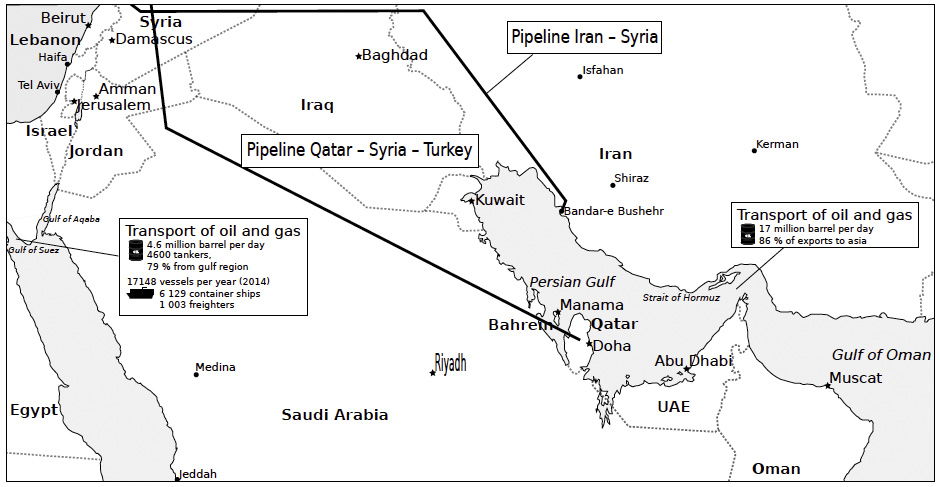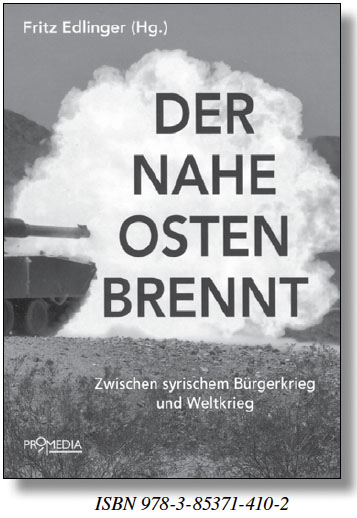Syria – between civil war and world war
Syria – between civil war and world war
by Wolfgang van Biezen
Our media still spread disinformation. Is it really true that Turkey is taking steps towards Russia, although it is an important NATO member? Is it in fact true that Turkey combats and curries favour with the Kurds at the same time? ... Do we after all still know why there is war in Syria?

The book “Der Nahe Osten brennt (The Middle East Burns)”, edited by Fritz Edlinger in the Viennese Promedia Verlag – with contributions from renowned Syrian and Middle East experts, clarifies.
The interested reader is recommended to start with the chapter “Erdogan’s Syrian Adventures”, since the highly differentiated articles on the Kurds, the Christians, the Alawites and other minorities in Syria, the chapter on the German media or the one that illuminates the (international) legal aspect.
As at the beginning of the 1970s, the Shell company discovered a huge natural gas deposit in exploration drilling in search of oil in Qatar, even the experts did not realise that it was the largest natural gas deposit in the world. What the experts knew, however, was the fact that a little more than a third of this deposit lay under Iranian soil and that this circumstance was almost bound to result in a tremendous potential for conflicts.
Instead of splitting up this treasure of nature for the sake of the two peoples of Qatar and Iran, as usual among good neighbours, secret diplomacy began its unfortunate hustle and bustle. The then Qatar Emir Ahmad ibn Ali Khalifa ibn Hamad did not like to divide and pondered about how this natural gas deposit would be most cleverly exploited for his own benefit and the Iranian neighbour. He stake everything on the Anglo-American card and hence accepted the extreme case for both parties involved, the casus belli.
Although Qatar was a little sheikhdom at that time, it did not fear Iran. The second Gulf War threw Iran decades back in its funding opportunities for oil, and when the UN imposed an economic embargo against Iran, everything seemed to run perfectly for Qatar. When the US set up its headquarters for wars in the Middle East in Qatar in 1998, Qatar began to bustle on the world political stage.
For the US, the huge Qatar natural gas deposit seemed to be the opportunity to throw the energy supplier Russia out of the market via the “North Stream” pipeline exclusively with Germany and thus to Europe.
However, although Qatar had good relations to their Sunni neighbour Saudi Arabia and the Kingdom of Jordan, although there was an Anglo-American alliance, and, for many incomprehensible, the support of Israel, and above all a geopolitically most favourable position, Qatar faced a grave problem. Due to its geographical location on the Persian Gulf and the fact that Qatar did not own a pipeline, which would initially transport the gas to the Turkish Mediterranean port of Ceyhan and from there to Europe, it was forced to ship the (Qatari-Iranian) natural gas in its own facilities on ships. Beforehand they had to liquefy the gas, which was relatively expensive, slow, and it was quite expensive to offer the gas on the world market. The agreement of Bashar al-Assad was necessary to use a pipeline to quickly exploit the natural gas storage and to reach the Turkish port of Ceyhan via Saudi Arabia, Jordan and Syria.
He refused his approval of solidarity with Russia, which he, as the elected President of the Republic, was perfectly well-informed in international conventions and international law. When it became known that Assad also wanted to allow Russ-land a planned pipeline to Iran to transfer the gas transport of both countries across Syria to Turkey, Bashar al-Assad crossed the plan, carefully developed by the US, to upgrade Qatar and in turn supply the market with favourable natural gas.

Immediately after the announcement of the Syrian-Russia-Iran natural gas supply axis, Sunni minorities in southern Syria, the city of Daraa, Jordan, Saudi Arabia and Turkey were instrumentalised with a logistical help from the USA for a (international) civil war, then “Arab Spring” called. This, like its predecessors in Tunisia, Libya and Egypt, well camouflaged and media-effective for the world publicity, should expand to a field fire.
A brand that today deals with all its implications, such as the impending war of Western Europe with Russia and the immeasurable fugitive.
From this point of view, the subtitle of the book by Fritz Edlinger “Between the Syrian Civil War and the World War” becomes clear because basically the war in Syria has become a proxy war between the USA and Russia. The frontline of Ukraine is continuing in the Persian Gulf. The “Kurdish Question”, which is also dealt with in detail in the book, now contains the necessary explosives for the next wars. If the Kurdistan favoured by Hillary Clinton were to come about, the US could control Turkey, Syria, Iraq and Iran from there. Israel, which is also dependent on the pipelines running through Syria (Golan heights) due to natural gas foundations in the eastern Mediterranean, and how Qatar has a transport problem, has an existential interest in the fall of Bashar al-Assad. Saudi Arabia wants to set up a loading port in Yemen in the port of Al Makalla and is already bombing the way.
After reading this extremely differentiated and carefully compiled book, it is to be desired that humanity recall the experiences of two world wars and to seek the negotiation table, for the benefit of its peoples, before and not only after a new world war. •